 |
 |
 |
| |
Pharmacokinetic Analysis and Liver Concentrations of a Series of Macrocyclic Peptidomimetic Inhibitors of HCV NS3/4A Protease: Identification of ITMN-191, a Potent NS3/4A Protease Inhibitor with High Liver Exposure Across Multiple Species
|
| |
| |
Reported by Jules Levin
DDW, May 2006, Los Angeles
Robert A Rieger2, Patrice A Lee2, Scott Seiwert1, Steven W Andrews2, Thomas K Pope2, Jed Pheneger2, Nick Neitzel2, Ronald B Franklin2, John A Josey2, and Lawrence M Blatt1
1InterMune, Inc., Brisbane, CA, USA
2Array BioPharma, Boulder, CO, USA
ABSTRACT
Inhibition of the HCV serine protease, NS3/4A, represents a promising new strategy for the control of chronic HCV infection. Given that viral replication of HCV is reported to occur primarily in hepatocytes, achieving high drug concentrations in liver is believed to be critical to the clinical success of protease inhibitors. In addition, clinical trials with peptide-based NS3/4A protease inhibitors have demonstrated a positive correlation between the magnitude of antiviral effect and the trough concentration of drug in plasma, which is thought to be a surrogate for trough concentrations of drug in liver.
With the goal of identifying potent NS3/4A protease inhibitors providing high liver concentrations, particularly at trough, we analyzed a series of macrocyclic peptidomimetic inhibitors for plasma pharmacokinetic (PK) parameters and liver concentrations following a single oral dose of 30 mg/kg to Sprague-Dawley rats. These data demonstrated that modest structural changes resulted in radically different compound ratios between liver and plasma. ITMN-191 provided an average liver Cmax of 3,098-fold the replicon EC90 value and much lower exposures in plasma (10-fold less). ITMN-191 concentrations in plasma and liver were further examined in multi-dose PK studies in rats, dogs, and monkeys.
Following a 7-day PO BID dosing regimen of 30 mg/kg in rats, average concentrations of compound in liver at apparent Cmax and trough were 1,646-fold and 152-fold the EC90 value, respectively, after the last dose on Day 7. A liver-to-plasma ratio of 2.4:1 was observed at apparent Cmax. Following a 7-day PO BID dosing regimen of 15 mg/kg in beagle dogs, average concentrations of compound in liver at apparent Cmax and trough were 3,048-fold and 58-fold the EC90 value, respectively, after the last dose on Day 7. A liver-to-plasma ratio of 51:1 was observed at apparent Cmax.
Lastly, following a 7-day PO BID dosing regimen of 15 mg/kg dose in cynomolgus monkeys, average concentrations of compound in liver at apparent Cmax and trough were 238-fold and 52-fold the EC90 value, respectively, after the last dose on Day 7. A liver-to-plasma ratio of 70:1 was observed at apparent Cmax.
In conclusion, the high Cmax and trough liver concentrations of ITMN-191 across three preclinical species contributed to the decision to nominate it for further development.
Author Summary & Conclusion
- Potency: Subtle changes to the macrocycle P1' & P2 exhibited single or double digit-nM Replicon potency (IC50) against HCV protease NS3/4A.
- Exposure: Rat PK revealed an orally bioavailable series where modest structural changes resulted in large exposure differences among compartments, but generally, liver concentrations were greater than plasma concentrations. Following a single PO dose of ITMN-191 at 30 mg/kg, liver concentrations at Cmax,app and 12-hr trough were - 1-log10 greater in rats than in monkeys.
- Liver : Plasma Ratio: Exposure between liver & plasma varied as much as 2-log10 among structural analogs in rat PK. Following a single PO dose of ITMN-191 at 30 mg/kg, liver : plasma ratios were different between rat (10:1) and monkey (120:1). For a given species the liver : plasma ratio remained nearly constant for the time course emphasizing the use of plasma concentrations as a surrogate for ITMN-191 liver concentrations.
- Liver concentrations of ITMN-191 at 12-hr trough support HCV replicon reduction of >/= 3-log10 (rat) and 2-log10 (dog & monkey).
Factors Affecting Liver Exposure:
- Intestinal absorption and P-gp interaction
- Plasma protein binding
- Hepatic blood flow
- Transporter-mediated hepatic uptake
- Metabolic clearance
- Transporter-mediated hepatic efflux
- Biliary clearance
- Liver disease(s)
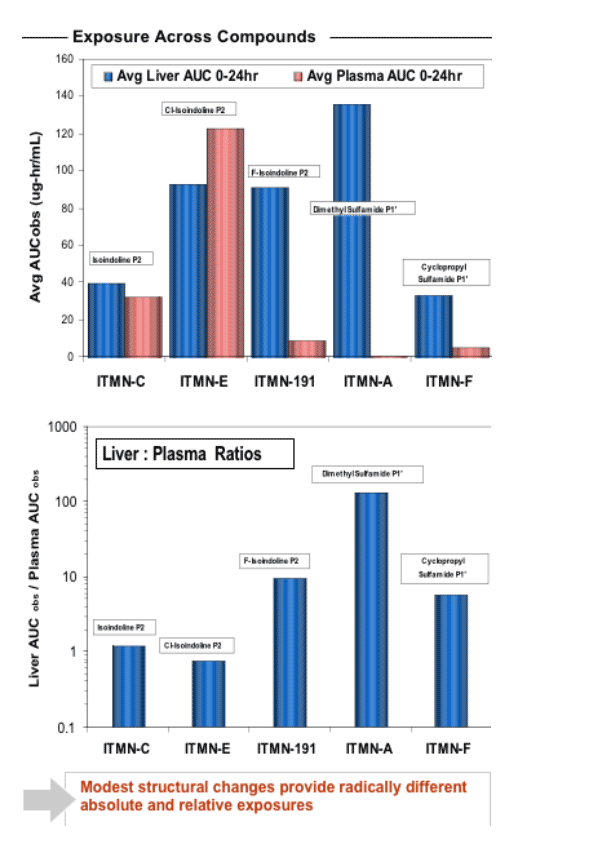
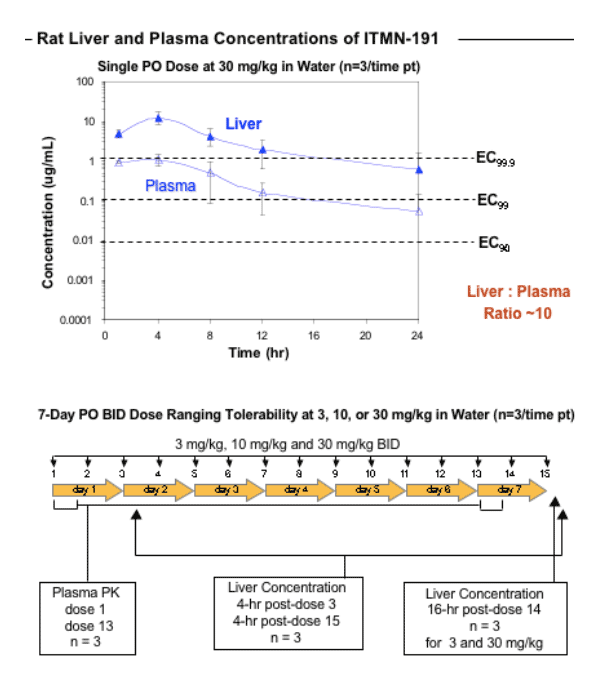
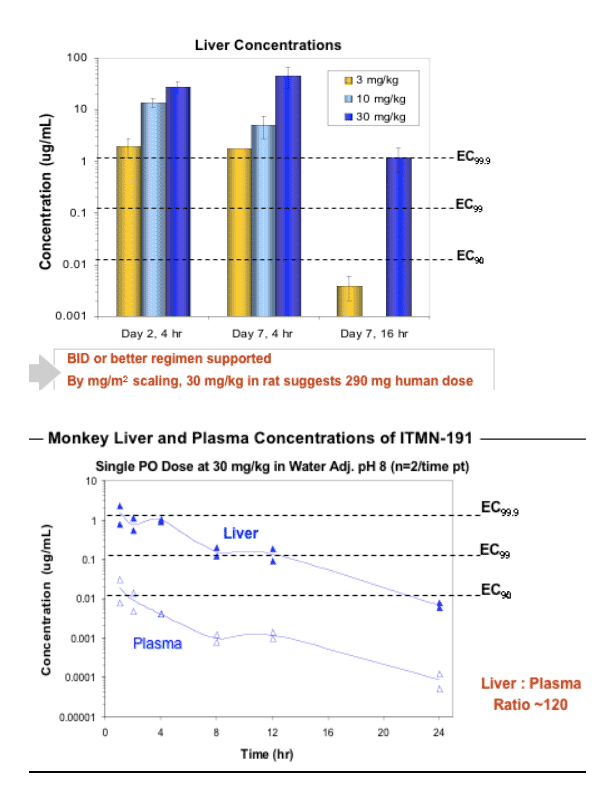
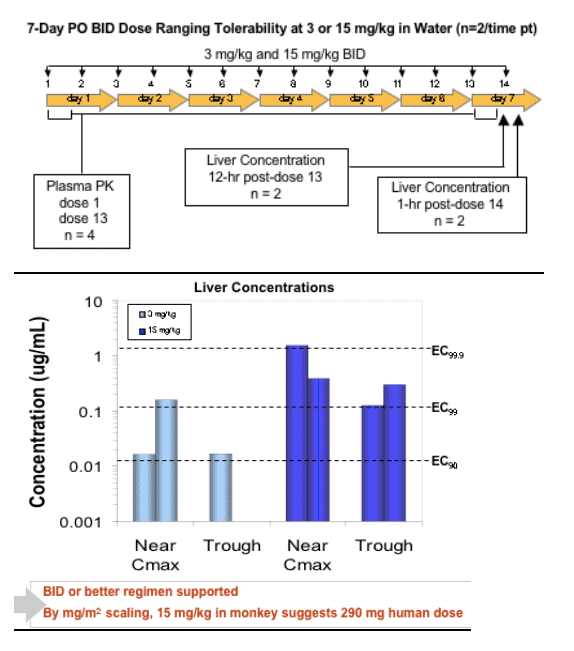
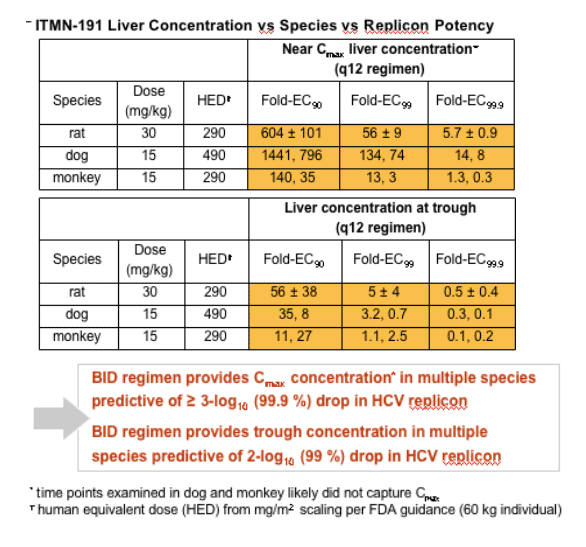
|
| |
|
 |
 |
|
|